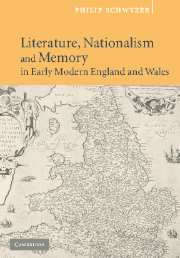Book contents
- Frontmatter
- Contents
- Acknowledgments
- Note on the text
- Introduction: remembering Britain
- 1 Spenser's spark: British blood and British nationalism in the Tudor era
- 2 Bale's books and Aske's abbeys: nostalgia and the aesthetics of nationhood
- 3 “Awake, lovely Wales”: national identity and cultural memory
- 4 Ghosts of a nation: A Mirror For Magistrates and the poetry of spectral complaint
- 5 “I am Welsh, you know”: the nation in Henry V
- 6 “Is this the promised end?” James I, King Lear, and the strange death of Tudor Britain
- Bibliography
- Index
1 - Spenser's spark: British blood and British nationalism in the Tudor era
Published online by Cambridge University Press: 07 December 2009
- Frontmatter
- Contents
- Acknowledgments
- Note on the text
- Introduction: remembering Britain
- 1 Spenser's spark: British blood and British nationalism in the Tudor era
- 2 Bale's books and Aske's abbeys: nostalgia and the aesthetics of nationhood
- 3 “Awake, lovely Wales”: national identity and cultural memory
- 4 Ghosts of a nation: A Mirror For Magistrates and the poetry of spectral complaint
- 5 “I am Welsh, you know”: the nation in Henry V
- 6 “Is this the promised end?” James I, King Lear, and the strange death of Tudor Britain
- Bibliography
- Index
Summary
In 1485, the heir to the ancient throne of Britain came home to claim his birthright. Commanding a predominantly “British” (Welsh and Breton) army, he defeated the English and, by some accounts, personally slew their vile king. His Welsh soldiers knew this man as “Harri Tudur,” and saw in him the prophesied redeemer who would free them from centuries of English imperial domination. The English would know him as Henry VII, or Henry Tudor; their historians, in times to come, would credit him with founding the dynasty under which a proud and imperial England came into its own. Incompatible as they seem, both versions of the battle of Bosworth and its consequences are in some ways true, and both must be kept in mind if we are to understand the development in the following century of the distinctively Tudor vision of nationhood which I term British nationalism. The aim of this chapter is to trace the evolution of that grand vision, and at the same time to follow the fortunes of a single emblematic image, that of a spark from the island of Anglesey bursting into flame. The complex itinerary of this image will transport us from the Welsh patriot-bards of the fifteenth century, fanatically opposed to English domination, to the Elizabethan patriot-poet Edmund Spenser, himself an agent of that domination in Ireland.
- Type
- Chapter
- Information
- Publisher: Cambridge University PressPrint publication year: 2004



